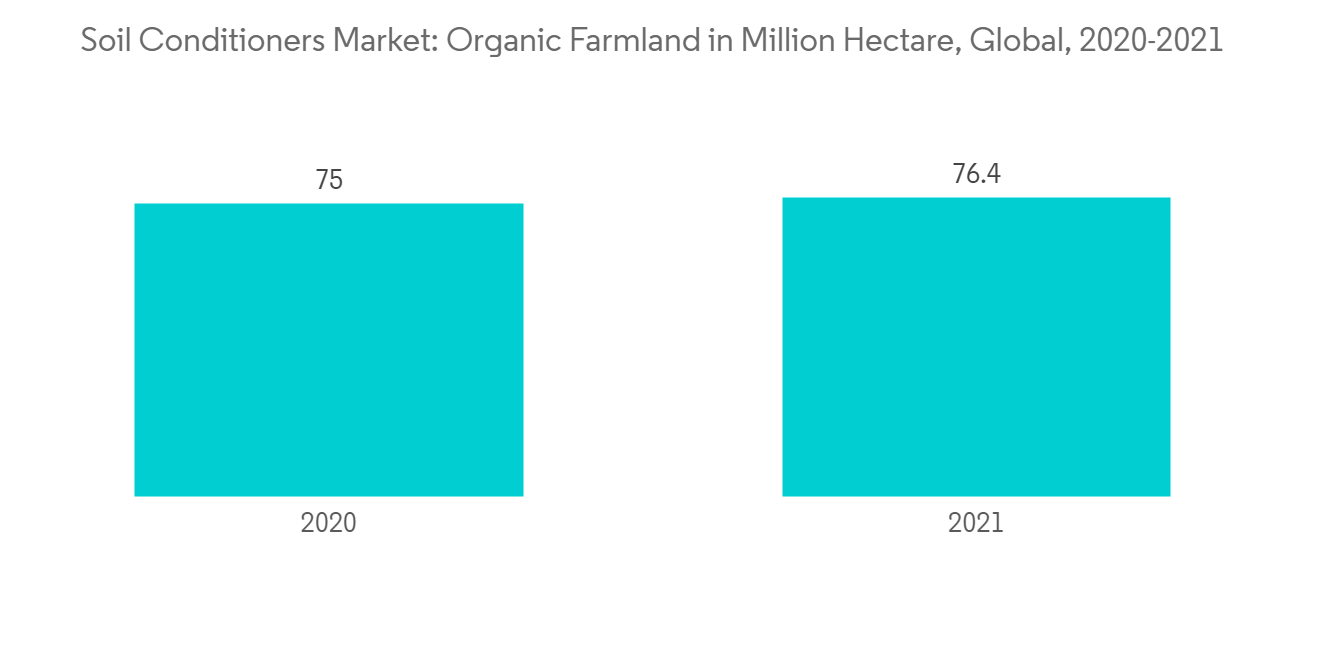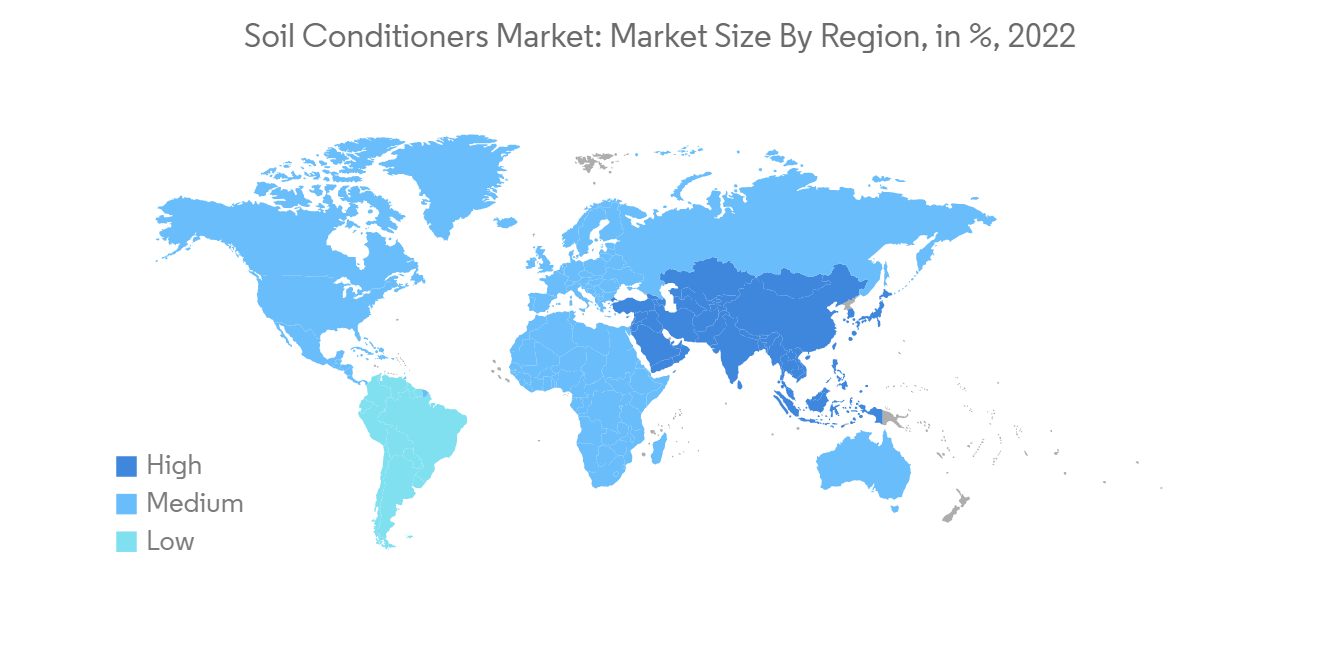 |
市场调查报告书
商品编码
1273472
土壤调理剂市场——增长、趋势、COVID-19 的影响和预测 (2023-2028)Soil Conditioners Market - Growth, Trends, and Forecasts (2023 - 2028) |
||||||
※ 本网页内容可能与最新版本有所差异。详细情况请与我们联繫。
在预测期内,全球土壤改良剂市场预计将以 5.8% 的复合年增长率增长。
主要亮点
- 由于大量使用化肥,土壤退化是一个全球性问题,导致有机质和土壤肥力枯竭。 另一方面,伴随着城市化和工业化的农业集约化正在迅速加速废弃物的产生。
- 例如,世界范围内的煤矿开采产生了大量废物,其中大部分被倾倒在垃圾填埋场和水库大坝中。 因此,可持续食品生产正在推动全球创新,以更好地利用各种废物并创造土壤改良剂等增值产品。
- 如今,土壤改良剂在改善植物生长、土壤健康和减少化肥使用方面发挥着重要作用。 例如,芬兰南部农田的磷径流是波罗的海地区水质和海洋生物资源的最大威胁,而传统的耕作方法在该地区已被证明是不够的。 因此,使用石膏作为农田的土壤改良剂可以减少 50% 的径流污染,减少对原始矿山磷的需求,并回收工业废料。 这将推动未来几年市场的增长。
- 土壤管理已成为一个日益重要的全球性问题。 根据联合国粮食及农业组织 (FAO) 的数据,世界上 38% 的土壤发生退化,导致土壤有机质流失、盐分、酸度或碱度升高,以及肥力下降。 土壤条件和结构的退化、粮食安全的需要以及土壤养分管理的加强是未来几年推动土壤改良剂市场增长的一些因素。
土壤调理剂的市场趋势
土壤条件和土壤结构退化
- 根据联合国粮食及农业组织 (FAO) 的数据,到 2050 年,灌溉土地预计将增加 3200 万公顷,其中已收割的灌溉土地将增加 17.0%。 预计这些情景将在发展中国家出现,导致作物养分供应短缺。
- 据联合国估计,全球约有 19 亿公顷土地失去生产力,20 亿人受到土地退化的影响。 如果土地退化以这种速度继续下去,据说到 2050 年,地球上 95% 的土地将退化。 结果,最终产品的质量下降,作物产量下降。
- 此外,世界人口的增长正在减少用于粮食生产的耕地比例。 因此,需要在土壤贫瘠的地方进行栽培。 土壤退化通过水土流失加剧、过度放牧、森林砍伐、采矿和工业发展等人类活动直接或间接影响农业生产力和水质。 土壤改良剂和灌溉使用效率的提高解决了土壤条件的输入方面,这推动了最近的土壤改良剂市场。
- 世界各地的农民使用绿肥和堆肥等土壤改良剂来恢復土壤肥力并改善土壤结构,使植物能够有效吸收养分和水分。 根据有机农业研究所(德语:Forschungsinstitut fur biologischen Landbau)(FiBL)的数据,2021年全球有机农田将比上年增加7640万公顷。 市场上的公司正在推出新产品以满足农民改善土壤状况和结构的愿望。

亚太地区主导市场
- 由于广阔肥沃的土地和有利的气候条件,亚太地区被认为是最大的农产品市场之一。 儘管有这些有利条件,但为满足该地区的粮食需求而进行的频繁种植加剧了土壤退化。 在这种情况下,堆肥等土壤调理剂作为化肥的替代品或补充剂发挥着重要作用,为贫瘠的土壤补充养分。
- 在印度等国家/地区,农民堆肥和绿肥等有机肥料是最古老、应用最广泛的植物营养方式。 据联合国粮农组织(FAO)报告,由于印度饲养大量动物,农田堆肥是最丰富的有机肥料,牛占该国化肥产量的90%。
- 水土流失、砍伐和砍伐森林的速度加快,导致农民依靠土壤改良剂来提高产量和土壤健康,以满足当地不断增长的人口对粮食的需求。 尤其是在中国这样的市场,由于集约化种植,化肥和农药被过度使用,土壤在过去几十年里已经严重退化。 种植者现在正在寻找解决土壤问题的有效方法。 领先的生产商正在投资研发创新新产品线,解决与土壤相关的问题,以便在不损害作物生产的情况下使该地区可持续发展。 因此,这有望在未来推动土壤调理剂市场。

土壤调理剂行业概况
市场高度分散,许多国内外参与者活跃在市场上。 UPL Limited、Saint-Gobain Group、Omnia Holdings Limited、Evonik Industries AG、Sanoway GmbH 是市场上的一些知名企业。 这些公司开发新产品以满足不同地区种植者的需求。 这些公司不仅在产品质量和产品推广方面竞争,而且还推动其他战略举措,如收购和扩张,以获取更大的份额并扩大他们赢得的市场规模。我把
其他福利:
- Excel 格式的市场预测 (ME) 表
- 3 个月的分析师支持
内容
第一章介绍
- 调查假设和市场定义
- 本次调查的范围
第二章研究方法论
第 3 章执行摘要
第四章市场动态
- 市场概览
- 市场驱动力
- 市场製约因素
- 波特的五力分析
- 买家的议价能力
- 供应商的议价能力
- 新进入者的威胁
- 替代品的威胁
- 竞争公司之间的敌对关係
第 5 章市场细分
- 产品类型
- 有机
- 堆肥
- 绿肥、牲畜粪便
- 泥炭
- 其他有机
- 无机物
- 聚合物
- 石膏
- 有机
- 地区
- 北美
- 美国
- 加拿大
- 墨西哥
- 其他北美地区
- 欧洲
- 西班牙
- 英国
- 法国
- 德国
- 意大利
- 俄罗斯
- 其他欧洲
- 亚太地区
- 中国
- 印度
- 日本
- 澳大利亚
- 其他亚太地区
- 南美洲
- 巴西
- 阿根廷
- 其他南美洲
- 非洲
- 南非
- 非洲其他地区
- 北美
第六章竞争格局
- 最常采用的策略
- 市场份额分析
- 公司简介
- UPL Limited
- Southern Petrochemical Industries Corporation Ltd(SPIC)
- Saint-Gobain Group
- Omnia Holdings Limited
- Sanoway GmbH
- Evonik Industries AG
- Mangalore Chemicals & Fertilizers Limited
第7章 市场机会未来动向
The global soil conditioners market is projected to register a CAGR of 5.8% during the forecast period.
Key Highlights
- Due to the intensive use of fertilizers, soil degradation has become a global problem, leading to the depletion of organic matter and soil fertility. Meanwhile, the intensification of agriculture accompanied by urbanization and industrialization has drastically accelerated the waste generation rate.
- For instance, coal mining produces wastes in large quantities globally, most of which end up in landfills or dump into storage dams. Accordingly, sustainable food production is driving global innovations to utilize various waste materials better to make value-added products, such as soil conditioners.
- Nowadays, soil conditioners are important in improving plant growth and soil health and reducing chemical fertilizer use. For instance, Phosphorus run-off from agriculture fields in southern Finland is the largest threat to water quality and living marine resources in this area of the Baltic Sea, and traditional farming methods have proven inadequate. So, using gypsum as a soil amendment on agricultural fields will reduce run-off pollution by 50%, decrease demand for virgin-mined phosphorus, and reuse industrial waste. This will encourage the growth of the market in the coming years.
- Soil management is an increasingly important global issue. According to Food and Agriculture Organization (FAO), 38% of global soil has been degraded, which causes the loss of soil organic matter, salinity, acidity, or alkalinity, and a decline in fertility. The degradation of soil conditions and structure, the need for food security, and enhanced nutrient management in the soil are some factors driving the market growth for soil conditioners in the coming years.
Soil Conditioners Market Trends
Degradation of Soil Condition and Soil Structure
- According to the Food and Agriculture Organization (FAO), the land equipped for irrigation is expected to expand by 32.0 million hectares, while harvested irrigated land is expected to expand by 17.0% by 2050. These scenarios are expected to be witnessed in developing countries, resulting in insufficient crop nutrient supply.
- According to a United Nations estimate, about 1.9 billion hectares of land have lost productivity, and 2 billion people are affected by land degradation globally. If land degradation continues at this pace, 95% of the Earth's land areas will be degraded by 2050. Thus, this leads to a lower yield of crops, along with a decline in the quality of the final product.
- The growing population worldwide is resulting in a decline in the proportion of arable land primarily used to produce food. This necessitates cultivation in poor soils. Soil degradation, directly and indirectly, affects agricultural productivity and water quality due to the increase in soil erosion, overgrazing, and other human-induced activities, such as deforestation, mining, industrial development, etc. Increasing soil conditioners and irrigation use efficiencies address the input side of the equation to the soil condition, which has been driving the market for soil conditioners in recent times.
- Farmers worldwide use soil conditioners, such as green manure, compost, etc., to recover soil fertility and address the soil structure so that it helps the plants take up nutrients and water efficiently. According to the Research Institute of Organic Agriculture (German: Forschungsinstitut fur biologischen Landbau) (FiBL), the global organic farmland had increased by 76.4 million hectares in 2021 compared to the previous year. Companies in the market are introducing new products to cater to the farmers' demands for improving soil conditions and structure.

Asia Pacific Dominates the Market
- Asia-Pacific is considered to be one of the largest markets for agricultural products due to its large fertile lands and favorable climatic conditions. Despite these favorable conditions, the region is witnessing severe soil degradation due to frequent cropping to meet the food demand. In such a scenario, soil conditioners, such as compost, play an important role as a replacement or supplement for chemical fertilizers in replenishing nutrient-depleted soil.
- In countries like India, organic manure, including farmyard manure and green manure, is the oldest and most widely practiced means of nutrient replenishment for plants. As per a report by the Food and Agriculture Organization (FAO), due to the high animal population in India, farmyard manure is the most common organic manure, with cattle accounting for 90% of the total manure production in the country.
- A rise in soil erosion rates, land clearance, deforestation, etc., have induced farmers to rely on soil conditioners to improve yields and soil health to address the growing food demand of the ever-increasing population in the region. Especially for markets like China, with excessive chemical fertilizers and pesticides applied to intensive cultivation, the soil has degraded mainly in the past decades. Now growers demand effective solutions to their specific soil problems. Major producers are investing in R&D to innovate new product lines to solve the problems related to the soil to make the region sustainable without causing any loss in the production of agricultural crops. Thus, this is expected to drive the market for soil conditioners in the future.

Soil Conditioners Industry Overview
The market is highly fragmented, with the presence of many local and international players operating in the market. UPL Limited, Saint-Gobain Group, Omnia Holdings Limited, Evonik Industries AG, and Sanoway GmbH are some of the prominent players who are operating in the market. These players are innovating new products that cater to the needs of growers across various regions. These companies are not only competing on the basis of product quality or product promotion but are also focused on other strategic moves, like acquisitions and expansions, to acquire a larger share and expand their acquired market size.
Additional Benefits:
- The market estimate (ME) sheet in Excel format
- 3 months of analyst support
TABLE OF CONTENTS
1 INTRODUCTION
- 1.1 Study Assumptions and Market Definition
- 1.2 Scope of the Study
2 RESEARCH METHODOLOGY
3 EXECUTIVE SUMMARY
4 MARKET DYNAMICS
- 4.1 Market Overview
- 4.2 Market Drivers
- 4.3 Market Restraints
- 4.4 Porter's Five Forces Analysis
- 4.4.1 Bargaining Power of Buyers
- 4.4.2 Bargaining Power of Suppliers
- 4.4.3 Threat of New Entrants
- 4.4.4 Threat of Substitute Products
- 4.4.5 Intensity of Competitive Rivalry
5 MARKET SEGMENTATION
- 5.1 Product Type
- 5.1.1 Organic
- 5.1.1.1 Compost
- 5.1.1.2 Green and Farmyard Manure
- 5.1.1.3 Peat
- 5.1.1.4 Other Organic Types
- 5.1.2 Inorganic
- 5.1.2.1 Polymers
- 5.1.2.2 Gypsum
- 5.1.1 Organic
- 5.2 Geography
- 5.2.1 North America
- 5.2.1.1 United States
- 5.2.1.2 Canada
- 5.2.1.3 Mexico
- 5.2.1.4 Rest of North America
- 5.2.2 Europe
- 5.2.2.1 Spain
- 5.2.2.2 United Kingdom
- 5.2.2.3 France
- 5.2.2.4 Germany
- 5.2.2.5 Italy
- 5.2.2.6 Russia
- 5.2.2.7 Rest of Europe
- 5.2.3 Asia Pacific
- 5.2.3.1 China
- 5.2.3.2 India
- 5.2.3.3 Japan
- 5.2.3.4 Australia
- 5.2.3.5 Rest of Asia Pacific
- 5.2.4 South America
- 5.2.4.1 Brazil
- 5.2.4.2 Argentina
- 5.2.4.3 Rest of South America
- 5.2.5 Africa
- 5.2.5.1 South Africa
- 5.2.5.2 Rest of Africa
- 5.2.1 North America
6 COMPETITIVE LANDSCAPE
- 6.1 Most Adopted Strategies
- 6.2 Market Share Analysis
- 6.3 Company Profiles
- 6.3.1 UPL Limited
- 6.3.2 Southern Petrochemical Industries Corporation Ltd (SPIC)
- 6.3.3 Saint-Gobain Group
- 6.3.4 Omnia Holdings Limited
- 6.3.5 Sanoway GmbH
- 6.3.6 Evonik Industries AG
- 6.3.7 Mangalore Chemicals & Fertilizers Limited













